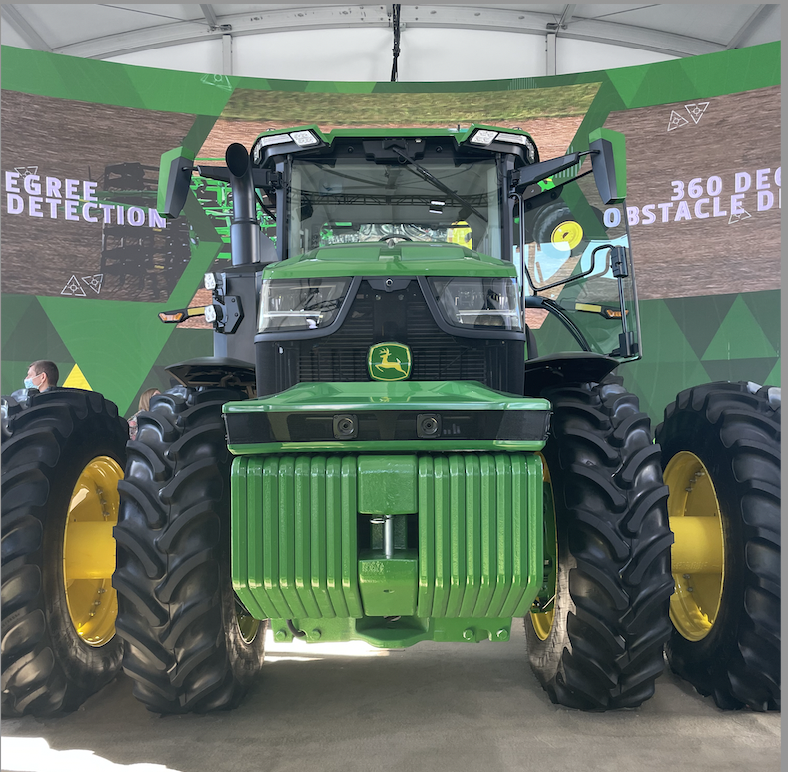‘Today, the fully autonomous portion is just tillage; tomorrow it may be planting, and after that it may be spraying,’ the manager of John Deere’s StarFire Network Al Savage told RCR Wireless News at CES
The most impressive thing about the 40,000-pound tractor that John Deere showed off at this year’s Consumer Electronics Show (CES) wasn’t its size. Rather, the towering piece of farming equipment is making headlines for being the first fully autonomous tractor. Designed to allow farmers to till their land autonomously and remotely, the autonomy kit can be installed in any John Deere tractor and will save them time — something farmer’s are notoriously short on — and help them address some of the industry’s most pressing challenges, like an increasing population to feed and a debilitating labor shortage.
The system’s six pairs of stereo cameras are combined with GPS guidance to create a reality in which a farmer can turn on and control the tractor from a smartphone. Once the tractor’s parameters are set, the farmer can walk away and attend to other business. Via an app that provides access to live video, images and data, the farmer can adjust the tractor’s orders (i.e. change speed or direction), monitor its job progress and receive alerts of anomalies the software doesn’t know how to handle.
At the same time, the tractor also gathers data about the health of crops in the field and other important business metrics.

John Deere was far from the only company focusing on some form of autonomous driving at CES. For instance, in a keynote address, Qualcomm’s CEO Cristiano Amon introduced the “the digital chassis,” a redefining of the vehicle base framework to include digital components, while Intel’s subsidiary Mobileye revealed three new autonomous vehicle SoCs.
However, what John Deere’s brand of autonomous driving proved is that, even with all the hype around 5G, nothing more than satellite connectivity is really needed to make a vehicle self-driving.
“The solution is all satellite-based,” the Manager of John Deere’s StarFire Network Al Savage told RCR Wireless News on-site at CES. “We collect all the information necessary for positioning and projection in deep space. Then we set up a bunch of different reference sites across the globe […] because the more points you have, the better your solution is going to be when you bring it all together.”
John Deere has more than 60 of these reference sites, and through them, an average calculation of the tractor’s position is developed, which is then sent to John Deere’s two processing centers.
“This is where we take the raw measurement [and] put in the necessary integers to make it a corrected signal. It comes out corrected, but it’s several different corrected signals, so when it gets to the LES, or Land Earth Station, the modulator will pick the best signal it receives out of what we just spit out,” explained Savage.
From there, the data is uplinked to a telecom satellite and the downlinked to the farmers.
“That’s the autonomy, knowing the tractor’s position and projection,” he said, adding that it took him longer to explain this process than for it to actually happen.
Of course, the value of the solution isn’t simply that it allows a tractor to drive itself, thanks to satellite data. Farmers do need cellular connectivity, 5G or otherwise, to access the full value of the solution because any data captured by the tractor is relayed and viewed on a smartphone or tablet.
As a result, explained the company’s Group Product Manager of Data & Integration Services Melissa Neuendorf, rural connectivity is “the highest priority for John Deere.”
“If [farmers] don’t have that cellular connectivity, they cannot be as efficient and productive,” she continued. “The autonomy and running the tractor is through the satellite, but all the data visualization runs through the cloud.”
Both Savage and Neuendorf shared that automation and autonomy are going to continue to be at the heart of John Deere’s plans moving forward.
“Today, the fully autonomous portion is just tillage; tomorrow it may be planting and after that it may be spraying,” said Savage, while Neuendorf stated that the long-term vision is enabling farmer’s to do more remotely “across the entire farming operation.”
Production of the autonomy kits is scheduled for this fall.

